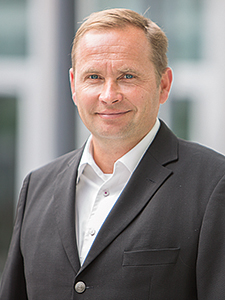“We wanted to give our office paper brand a visually attractive and narratively cohesive brand facelift. The technical properties of the paper were also adjusted to better meet today’s printing needs,” says Petteri Kalela, Vice President, New Business.
The New Future brand is designed around the use of renewable materials. “The fibres needed to produce our fine papers come from sustainably managed forests. After use, the same fibres can be recycled and reused,” Kalela says.

Petteri Kalela
Responsible Fibre trademark
New Future is the first product range to carry the new Responsible Fibre trademark adopted by UPM. According to Environmental Director Päivi Rissanen from the UPM Paper ENA business, the new trademark innovatively combines UPM’s environmental responsibility and social responsibility into one cohesive philosophy, which is followed throughout the product lifecycle.
“Responsible Fibre is truly unique. We wanted to introduce a trademark that shows that we are committed to ensuring that all our products carrying the trademark comply with the industry’s most demanding responsibility criteria.”

Päivi Rissanen
To be eligible for the trademark, the wood raw material for the product must be sourced from an FSC®- or PEFC™-certified forest where measures to guarantee biodiversity have been implemented.
The paper must also meet the requirements of the EU Ecolabel, and the production process must comply with all the applicable occupational and product safety requirements. UPM is additionally committed to operating in a responsible and ethical manner in all communities in which it operates.
Reason and emotion
Today, the average office worker uses up to 45 sheets of paper per working day, adding up to more than 10,000 printed A4 sheets per year (Waste and Resource Action Programme, UK, 2014). At such huge volumes, the paper you choose makes a difference. The old ‘Think before you print!’ slogan is starting to acquire a new meaning.
Not only does New Future offer peace of mind to users with high-volume printing needs, but consumers can also be confident that every sheet has a minimal impact: office papers are among the few UPM consumer products that require no further processing.
The lifecycle of the fibres often continues after the sheet is printed. UPM is one of the world’s top users of recycled paper: approximately 80% of the fibres used in its newsprint are recycled.
Will the market get the message?
The main potential hurdle is whether the market and consumers will understand the message of responsibility that lies behind the New Future brand and the Responsible Fibre trademark. Rissanen says that particularly among consumers, this requires a certain degree of awareness and familiarity with the sustainable use of natural resources.
“We aim to make the Responsible Fibre story as approachable as possible. And thanks to the attractive appearance of the New Future product packages, you no longer want to hide them in printing room cupboards. We feel that we have succeeded in making our message visible.”
Social responsibility, in particular, is becoming an increasingly topical and debated issue. Customers have their own risk management schemes and want to ensure that the paper production chain is ethical throughout.
“I hope that our customers will feel that they play a role in this story, but also that they can gain commercial advantage by using these products. We will follow how well Responsible Fibre is received on the market with great interest, and based on the response we will consider using the trademark on other UPM products as well,” concludes Kalela.
THE NEW FUTURE PRODUCT FAMILY includes three different grades of office papers: New Future Premium, New Future Multi and New Future Laser. Ideal for high-quality printing at the office or at home.
RESPONSIBLE FIBRE is a UPM trademark Created on the basis of official certifications and standards. The criteria cover the following four focus areas: climate, water, biodiversity and social responsibility Guarantees that the wood fibres used in UPM products come from sustainably managed forests Further information is available at www.responsiblefibre.upm.com
More on the subject at www.responsiblefibre.upm.com
Niko Kilkki
